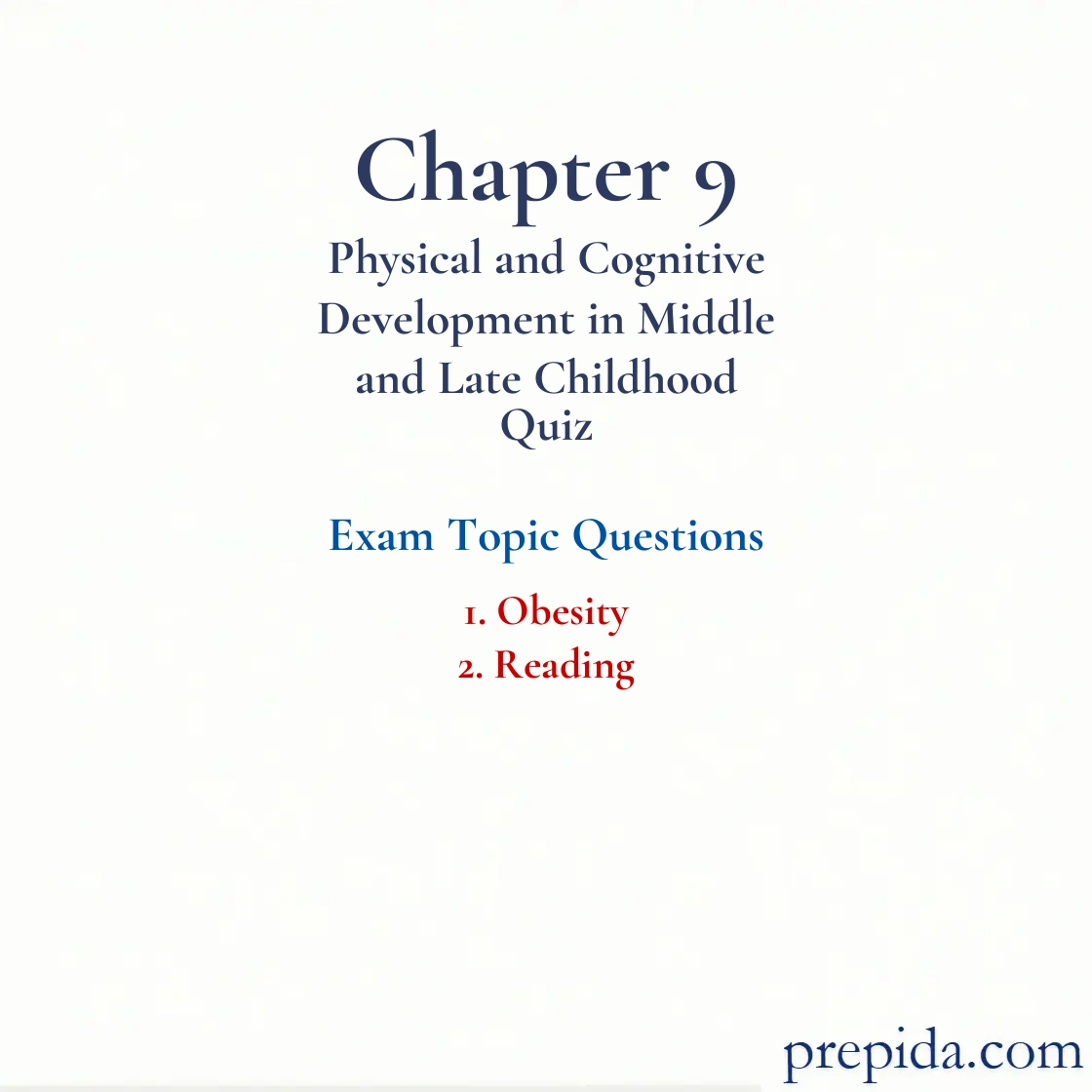
About This Chapter
This assessment preparation examines validating your expertise in topics such as obesity and reading. Supplies present practice questions with accurate answers, comprehensive explanations, and terminology definitions structured by difficulty ratings with accurate responses, detailed explanations, and glossary references. Immediate access to correct answers and detailed explanations ensures effective learning and quick verification.
The learning goals consist of the following:
✓ Summarize physical changes in middle childhood.
✓ Summarize language development in middle childhood.
Question 1
Being overweight is defined in relation to a person's
- height.
- body mass index.
- weight.
- waist circumference.
Correct Answer:
body mass index.
Question 2
Gertrude, 9, is at the 98th percentile in terms of her BMI. Her doctor would likely tell her parents that she is
- underweight.
- at risk for being overweight.
- overweight.
- obese.
Correct Answer:
obese.
Question 3
Sammy, a 9-year-old girl, is overweight. She is constantly teased and tormented by other children in school. Her parents try to cheer her up by telling her that they were also overweight when they were young and even now they are overweight but they don't worry about what others say about them. Based on the given information, which of the following is the primary cause for Sammy being overweight?
- Sammy spends most of her day playing on her computer.
- Sammy's meal times are irregular.
- Sammy does not exercise as regularly as her parents.
- Sammy's parents are overweight.
Correct Answer:
Sammy's parents are overweight.
Question 4
Mitchell is at the 96th percentile in terms of his BMI. His doctor would likely tell his parents that he is
- obese.
- overweight.
- at risk for being overweight.
- underweight.
Correct Answer:
overweight.
Question 5
Ross is at the 85th percentile in terms of his BMI. His doctor would likely tell his parents that he is
- obese.
- overweight.
- at risk for being overweight.
- underweight.
Correct Answer:
at risk for being overweight.
Question 6
Which of the following statements represents the current thinking among increasing number of experts in the field of reading?
- Direct instruction in the whole-language approach is a key aspect of learning to read.
- Direct instruction in phonics is a key aspect of learning to read.
- The whole-language approach and the phonics approach are equally effective in teaching children to read.
- The morphological approach has been shown to be the best way to teach reading.
Correct Answer:
Direct instruction in phonics is a key aspect of learning to read.
Glossary:
Phonics Approach: The idea that reading instruction should teach the basic rules for translating written symbols into sounds.
Question 7
The ________-language approach stresses that reading instruction should parallel a child's natural language learning.
- assisted
- remedial
- complex
- whole
Correct Answer:
whole
Glossary:
Language: A form of communication, whether spoken, written, or signed, that is based on a system of symbols. Language consists of the words used by a community and the rules for varying and combining them.
Question 8
At Jackson Elementary, children are taught to read by making them learn to recognize entire words and sentences and to use the context of the words that are given in the text to guess their meaning. Their reading material consists of stories, poems, newspapers, and magazines. This school is using the ________ approach to reading instruction.
- assisted-language
- remedial-language
- phonics
- whole-language
Correct Answer:
whole-language
Glossary:
Whole-Language Approach: An approach to reading instruction based on the idea that instruction should parallel children’s natural language learning. Reading materials should be whole and meaningful.
Question 9
The ________ approach to reading instruction emphasizes the teaching of basic rules for translating written symbols into sounds.
- whole-language
- phonics
- balanced-instruction
- morphological
Correct Answer:
phonics
Question 10
Louise is teaching her son to read by helping him sound out letters. She also plays a cartoon where the characters repeat the sounds of each letter. Watching her and the characters in the cartoon pronounce the letters, her son makes the effort to read aloud some of the letters. What approach is Louise using to teach her son?
- the whole-language approach
- the phonics approach
- the balanced-instruction approach
- the morphological approach
Correct Answer:
the phonics approach
Glossary:
Phonics Approach: The idea that reading instruction should teach the basic rules for translating written symbols into sounds.
Question 11
Alberta is a school teacher who introduces children to reading by teaching them a rhyme that goes "A for apple, A says ah, B for ball, B says buh," and so on. This exemplifies the ________ approach to reading instruction.
- whole-language
- phonics
- information-processing
- analytic
Correct Answer:
phonics